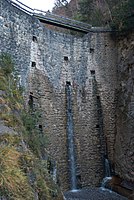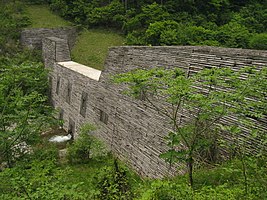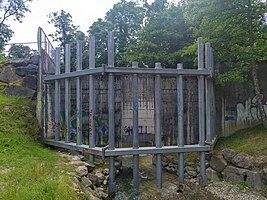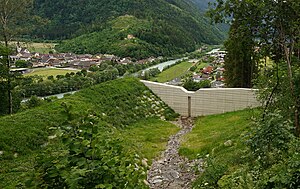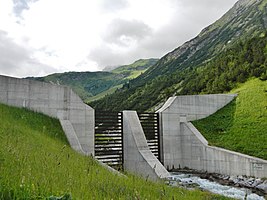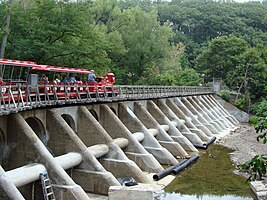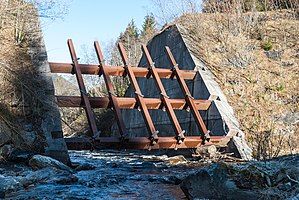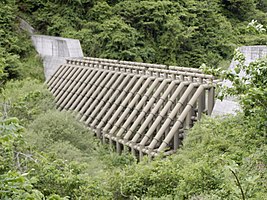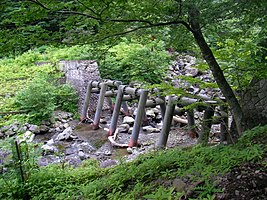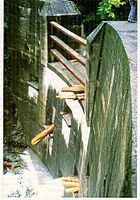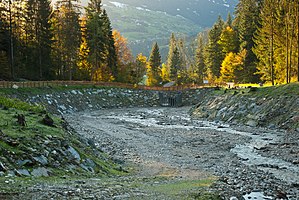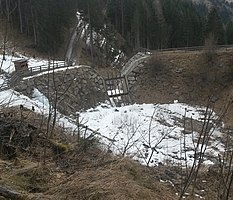Proposal:Check dam
| Check dam | |
|---|---|
| Proposal status: | Proposed (under way) |
| Proposed by: | Eginhard |
| Tagging: | waterway=check_dam |
| Applies to: | |
| Definition: | Barrier structures to reduce the speed of flow, prevent erosion and hold back debris on mountain torrents |
| Statistics: |
|
| Rendered as: | Similar to weirs and dams |
| Draft started: | 2021-04-09 |
| RFC start: | 2021-06-07 |
Proposal
This proposes
- waterway=check_dam to map check dams
- check_dam=* to specify the type of check dam
- check_dam:screen=* to describe the screen that might be on the check dam
- screen:material=* to describe the material of the screen (may also be used for screens on inlets and outlets)
Rationale
Check dams are sufficiently different from dams and weirs in form and function to warrant their own tag. They are frequently encountered along mountain streams to protect downstream settlements and infrastructure. Such streams can see sudden, dramatic increases in water flow, often accompanied by large amounts of debris (sediment and wood), that may be slowed or contained by check dams.
Check dams can be very large structures and may aid navigation. Some types of check dams need to be regularly accessed for maintenance and debris removal. Check dams and the debris basins behind them also present dangers in case of torrential flow events.
A previous proposal on torrent control structures proposed waterway=check_dam for solid and waterway=beam_dam for open check dams. The former has gained some traction and already tagged objects remain compatible with this proposal because check dams will be considered to be solid by default. The definition of waterway=beam_dam for open check dams was vague, the current proposal allows to provide more detail on different kinds of check dams through subtags.
Related tags: waterway=dam, waterway=weir, waterway=floating_barrier
Definitions and tagging
There are two main types of check dams:
- Solid (or closed) check dams
- Open check dams
Main tags
Map a check dam as a ![]() node on a stream or river. Larger check dams may be mapped as a
node on a stream or river. Larger check dams may be mapped as a ![]() way, where one node should be shared with the stream or river it crosses. Similar to waterway=weir and natural=cliff, the right side of the way should be the lower side, i.e. facing downstream.
Only the main transverse structure should be tagged as waterway=check_dam. Use, for example, man_made=embankment for earthen embankments extending from the check dam to surround a debris basin (example).
way, where one node should be shared with the stream or river it crosses. Similar to waterway=weir and natural=cliff, the right side of the way should be the lower side, i.e. facing downstream.
Only the main transverse structure should be tagged as waterway=check_dam. Use, for example, man_made=embankment for earthen embankments extending from the check dam to surround a debris basin (example).
| Key | Values | Description |
|---|---|---|
| waterway | check_dam | Main tag for any check dam |
| check_dam | solid, slit, slot, rake, beam, net, frame | Specifies the type of check dam (the default is assumed to be solid) |
| check_dam:screen | rake, beam, grill | Specifies the type of screen at the check dam opening (if it exists) |
| screen:material | metal, wood, ... | Specifies the material of the screen (if it exists) |
Tags used in conjunction
| Tag | Description | Example |
|---|---|---|
| name=* | Name of the check dam (if applicable) | ... |
| material=* | Describes the material of the main structure of the check dam | concrete, wood, metal, ... |
| height=* | Height of the main structure of the check dam | |
| operator=* | Name of the operator (if known) |
Solid check dams
Solid check dams are structures without larger openings through which debris can pass, so that sediment accumulates behind and most water flows over the top of the check dam. They can be somewhat permeable to water, especially simpler constructions from rock, wood or gabion, but concrete check dams also often have small weep holes for drainage.
Solid check dams are often characterized and can be distinguished from weirs by their wings, solid foundations that rise towards the sides in a V-shape and protect the riverbed from erosion. Water should never flow over the wings even during extreme flow events. Often many solid check dams are built in series to reduce the speed of flow in steep sections of a stream (with the foot of one aligned with the crest of the next one).
Open check dams
Open check dams allow free flow of water through the main structure during normal times. They can be further classified into different subtypes. Open check dams often have an access road to remove debris from the basin upstream of the check dam after torrential flow events.
Slot check dam
Check dam with holes (slots) during which water and smaller sediment can flow during normal times.
Slit check dam
Check dam with one or more narrow vertical slits.
Fin check dam
The main structure of the check dam are large fins, usually with a more gentle slope facing upstream.
Rake check dam
The main structure of the check dam consists of vertical piles.
Beam check dam
The main structure of the check dam consists of horizontal beams.
Net check dam
The check dam is a flexible net, often made from metal.
Frame check dam
Frame check dams consist of a rigid 3-dimensional structure, e.g. made of metal pipes. They are most common in Japan.
Screens
Check dams often also have a screen at the opening(s) to better retain or filter debris. This may be marked as check_dam:screen=rake (screen consisting of vertical elements), check_dam:screen=beam (screen consisting of horizontal elements) or check_dam:screen=grill (vertical and horizontal elements). If no better value is available, check_dam:screen=yes may be used to indicate the presence of a screen.
check_dam=slit, check_dam:screen=grill, screen:material=metal (with smaller solid check dams in the foreground)
Debris basins
Often, basins are built upstream of open check dams to temporarily store the debris retained by the check dam. They are only filled with water during torrential flow events. An access road allows removal of debris from the basin. Such basins should be tagged with basin=detention.
Related structures
The following features are also barriers across waterways, but should not be tagged with waterway=check_dam:
| Feature | Description | Example | Correct tagging scheme |
|---|---|---|---|
| Barrier that impounds the water to form a reservoir and normally does not have water flowing over the top.
Water can freely flow over or through check dams. They may impound water only temporarily during extreme flow events when their openings are clogged with debris. |
waterway=dam | ||
| Barrier across a stream or river over which water flows freely (usually along most of its length). Sediment should not accumulate behind them. Weirs raise the water level behind them for a certain distance. They can help prevent flooding and make rivers more navigable.
Solid check dams are backfilled with sediment, are found on steeper sections of a stream and usually have water flowing over only a small part of their width, thus do not influence the water level behind them. They are designed to handle sudden, dramatic increases in water flow and are built in areas where torrential flow events and floods are likely to happen. Often, several solid check dams in succession can be found on a short stretch of a stream (with the foot of one aligned with the crest of the next one). Water can freely flow through open check dams. |
waterway=weir | ||
| Flexible barrier that floats on the water surface and holds back debris or serves as a navigational barrier.
Check dams are more solid structures that can handle very different water levels and larger amounts of debris. |
waterway=floating_barrier | ||
| Structure that extends only partway into the river (or sea). Groynes redirect the flow of water and retain sediment and may also be used for flood control.
Check dams cover the entire width of the waterway. |
man_made=groyne | ||
| Screens directly attached to inlets/outlets | Inlets/outlets of culverts or tunnels may be equipped with screens to withhold trash and debris.
Check dams are independent structures. There may exist a separate check dam before a culvert inlet in which case it could be mapped as such. |
inlet=screen/outlet=screen (proposed) | |
| Basic screens to withhold trash and small debris that accumulate at normal flow rates.
Check dams are stronger structures that can handle very different water levels and larger amounts of debris during torrential flow events and floods. |
waterway=debris_screen |
Rendering
Check dams could be rendered similar to weirs and dams.
Features/Pages affected
- waterway=check_dam will be created
- waterway=dam and waterway=weir, to mention when waterway=check_dam should be used
- Examples of debris basins will be aded to basin=detention
External discussions
- Jun 2020 [talk-ch] Wildbachverbauungen
- Aug 2013 [forum] Geschiebesperren und Sperrentreppen
References
The proposed tagging follows these classifications of check dams with certain simplifications:
- Wehrmann, H., Hübl, J., & Holzinger, G. (2006, September). Classification of dams in torrential watersheds. In Proc., INTERPRAEVENT Conf (pp. 829-838).
- Hübl, J., Holzinger, G. and Wehrmann, H. (2003) Entwicklung von Grundlagen zur Dimensionierung kronenoffener Bauwerke für die Geschiebebewirtschaftung in Wildbächen: Klassifikation von Wildbachsperren, WLSReport 50 im Auftrag des BMLFUW VC 7a (unpublished), Band 2, p. 1–84.
Comments
Please comment on the discussion page.




